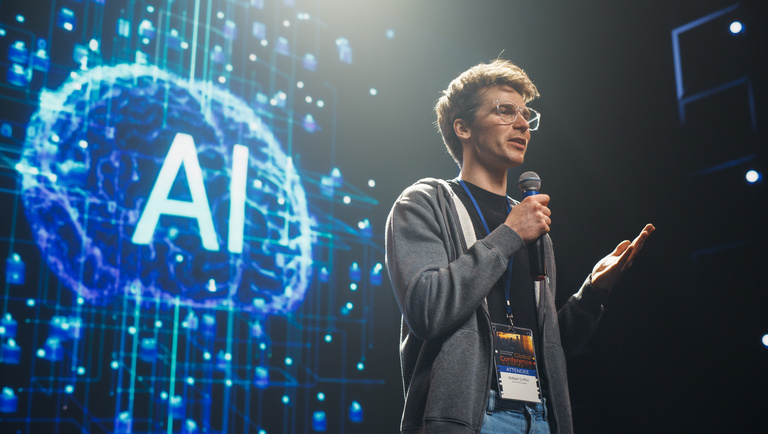
- Blog, Artificial Intelligence
- Published on: 28.10.2025
- 8:15 min
"Make AI Work Better for People": Why People Are the True Success Factor in AI
Artificial intelligence has become an integral part of business processes. However, while many projects still focus on automating as many tasks as possible, it is becoming increasingly clear that AI creates the most value when it assists people in complex situations. ServiceNow's slogan captures this perfectly: AI should work for people, not instead of them.
True progress does not lie in maximum automation, but in targeted support. Real added value is created where AI gives people clarity, accelerates decision-making, and strengthens collaboration.
We expect this prioritization to become increasingly important through 2028, as access to AI computing power may face growing constraints due to challenges in scaling AI factories and expanding the required energy and network infrastructure.
Given the foreseeable bottlenecks in computing power and infrastructure, companies are now more than ever faced with the question: How can AI be deployed where it truly improves processes, rather than simply being technically feasible?
Human-Centered AI: Key Takeaways
AI delivers real value when it supports people in complex situations rather than merely automating tasks.
AI excels at parallel data processing, pattern recognition, and context-based decision support.
Most organizations implement AI where it's easiest, not where it'll have the biggest impact.
Short-term pilot projects without strategic integration often lead to costly adjustments, wasted budgets, and untapped potential.
Sustainable success depends on a holistic use case strategy balancing profitability, integration, and user acceptance.
As infrastructure and energy constraints limit the expansion of AI computing resources, prioritization will become an even more decisive factor for sustainable success.
The Strengths of AI and Where Humans Remain Irreplaceable
Some tasks push human capabilities to their limits, no matter how much focus or experience you bring. These include processing massive data volumes in parallel, spotting subtle patterns in complex information streams, and interpreting context from multiple, often contradictory sources.
This is where AI shines. It works like a virtual parallel processor, running multiple analyses at once. Within seconds, it uncovers connections that would take humans considerable effort or might stay hidden entirely.
In essence, AI has two core strengths:
- Pattern recognition: AI spots anomalies or trends in complex datasets long before humans can see them.
- Context building: AI pulls together relevant information in real time from multiple sources to enable better decisions.
Some practical examples are:
- Ticket prioritization: Incoming support requests are automatically sorted by urgency, topic, and responsibility. In some cases, this includes machine analysis of complete error logs.
- What-if analyses in product development: The system automatically simulates the impact of swapping out a component, making risks visible and enabling smarter decisions.
- Proactive context research in procurement: Software purchase approvals get analyzed automatically to catch risks early and speed up price negotiations.
What used to be impossible to handle manually in any reasonable timeframe is becoming standard. This opens up entirely new ways to make workflows more efficient and intelligent. These aren't minor tweaks; they're deep, lasting changes.
The key takeaway: If positioned this way, AI doesn't just optimize processes; it transforms them fundamentally.
The AI Dilemma: Quick to Start, Rarely Sustainable
Many companies are currently experimenting with AI. A clear pattern emerges: projects that are easy to implement are prioritized, while long-term approaches are often neglected.
The current situation in many organizations:
As usual for initial adoption, AI is deployed primarily where it can be implemented quickly with minimal disruption to existing processes. Consequently, companies often overlook the long-term potential of AI, which lies in deeply transforming workflows.
We see recurring patterns in how companies approach AI in the workplace:
- Simple use cases: AI is applied to tasks such as reporting or writing data back into other systems when established interface solutions would be more efficient.
- Focus on quick pilots: Projects are launched because they promise a fast time-to-market but rarely involve strategic integration into the overall system.
- Rapid piloting without connection: Individual employees or teams develop AI solutions without sufficient expertise or integration into existing development networks. This results in isolated solutions.
Another challenge is that the "AI" label attracts investment even when the application area is not suitable. This leads to scenarios in which AI is used despite the fact that traditional solutions, such as API integrations or RPA systems, are often more robust, cost-efficient, and scalable in the long run.
There are already numerous examples of AI in the workplace that illustrate this phenomenon. Initiatives for retroactive optimization ("re-algorithmization") of AI agents have emerged, and AI is frequently used as a quick tool for prototypes. A stable technical foundation, if one is established at all, usually comes much later.
Why AI Infrastructure Could Become a Growth Bottleneck
Scaling AI factories differs significantly from building the data centers we have known over the past decades. They require a stable and substantial energy supply – something that takes time to establish.
The business model is comparable to aviation: airplanes generate revenue only while they are in the air. When they stand idle, they incur costs instead. Similarly, AI factories must maintain continuous operation to stay profitable, which leads to a constant and substantial energy demand.
Delays in building this energy infrastructure – especially in a sustainable and environmentally responsible way – are likely to increase costs or even limit the availability of AI computing power throughout this decade.
The alignment that is truly needed
From a human-centered AI perspective, companies should use AI in the workplace to meaningfully improve processes rather than simply using it wherever it is technically possible. What matters isn't the number of automated tasks but the sustainable value created for people and organizations – and the effective use of increasingly limited AI compute capacity.
The good news is that most companies have already gained initial experience with AI and are no longer starting from scratch. The next step is crucial: shifting from just "doing AI" to having clear strategic focus.
Guiding questions for strategic realignment
To deploy AI where it truly creates value, clarify these key questions upfront:
- In which areas do humans reach their limits, and where can AI provide targeted support?
- Where do these efficiencies and accelerations generate the greatest positive impact?
- Which tasks can AI take over specifically, how will results be verified, and which activities should remain firmly in human hands?
Equally important is reviewing existing AI pilots:
- Where have they succeeded, and where have they fallen short?
- What are the underlying causes?
- How can individual solutions be integrated into a consistent overall picture?
- How can short-term pilots be scaled into robust, long-term solutions?
- What has the organization learned, and who is best prepared for the next step?
A strategic and practical approach
These steps help organizations sustainably and economically leverage existing experience to use AI in the workplace.
- Clarify guiding questions: Quickly assess costs, benefits, opportunities, and risks across all value levers. Challenge assumptions and compare with past Shared Service Center projects.
- Activate experience: Use existing skills and use cases for the next steps, developing them strategically.
- Set up a connected control center: Establish an AI center to monitor costs, benefits, and use cases while coordinating between AI systems and traditional IT. Avoid creating isolated AI silos.
- Advance projects: Review current AI initiatives and categorize them as either Quick Wins (easily achievable benefits) or Strategic Impacts (long-term, sustainable effects).
- Re-algorithmization: Optimize inefficient AI systems or convert them into traditional automations to strengthen the focus on strategic impacts.
- Ensure communication: Implement continuous communication and change management that emphasizes holistic effects and optimizes total cost of ownership (TCO).
How MHP Supports Companies With Human-Centered AI
For AI to deliver long-term value in the workplace, it must move beyond pilot projects. A clear plan and tailored implementation are essential. MHP guides organizations with a practical, strategic approach.
- Situation review and use case evaluation: Analyze existing AI initiatives and assess which applications deliver the greatest value to people and the organization.
- Strengthen the business case: Review your business case across different value levers and refine or reprioritize as needed.
- Strategic alignment: Develop a roadmap that considers AI in three scenarios: as a game changer, for rapid piloting, and for re-algorithmization programs.
- Technology optimization: Enhance AI management systems ("control center") and automations to ensure the efficient operation and governance of AI solutions.
- Integration with existing systems: Seamlessly integrate AI solutions and governance with current technologies to prevent process disruptions.
- TCO focus and monitoring: Prevent cost traps by taking a holistic view of the long-term total cost of ownership.
- Change communication: Support cultural transformation to foster adoption and ensure smooth integration into daily work.
This approach ensures that AI is seen as part of a clear corporate strategy, not an isolated technical project. The goal is to make people's work lives noticeably easier, streamline processes, and achieve better long-term results.
Conclusion: Technological Progress Is Not an End in Itself
AI only delivers its true value when it strengthens people rather than replacing them. The key lies in human-centered AI that seamlessly integrates into existing organizations and teams, supporting their work in targeted ways. Before implementing technologies, it is essential for companies to enhance human judgment, build trust, and define clear objectives.
AI becomes a strategic – and at least short-term constrained – lever that accelerates processes and ensures sustainable success only when technological and organizational development go hand in hand. MHP supports you on this journey, from the initial idea to successful implementation, with a practical, holistic approach that always prioritizes quality over quantity.
Turn AI potential into tangible results. With a clear strategic focus and proven methods, we create solutions that deliver impact today and in the future.
FAQ
Automation means recurring, clearly defined tasks run without human intervention. Real relief through AI goes further: it supports people in complex situations, helps prioritize tasks, delivers contextual information, and recognizes patterns that are difficult for humans to spot or only become visible after lengthy analysis. This doesn't just create efficiency, it expands human capabilities.
A clear AI application goes beyond purely repetitive tasks. Scenarios make sense when you're dealing with large data volumes, unclear structures, or high information density. What's crucial is that implementation is economically viable long-term and the AI-supported solution actually creates value for work processes and employees.
In most cases, the reason is a lack of strategic focus. Projects are often launched because the technology is available, not because it is the best solution to the problem. Plus, integration into existing processes often gets underestimated, leading to team buy-in problems and high ongoing costs.
Transparent communication and the early involvement of employees are essential. Teams need to understand how the technology works, what benefits it provides, and where its limitations lie. Training, pilot projects, and regular feedback loops build trust and help reduce fears.
This refers to applying AI where human capabilities reach their limits, such as analyzing complex datasets, identifying patterns, and supporting context-based decisions. The goal is not to replace simple tasks, but rather to support employees in demanding areas and enhance their overall performance.
AI factories have unique requirements in terms of stable power and network infrastructure. Building and engineering these components – including power plants, energy and network systems, and cooling facilities – involves much longer planning and implementation cycles than traditional data centers.
Additional delays can arise from extended environmental review procedures in highly regulated markets, for example, within the EU.
